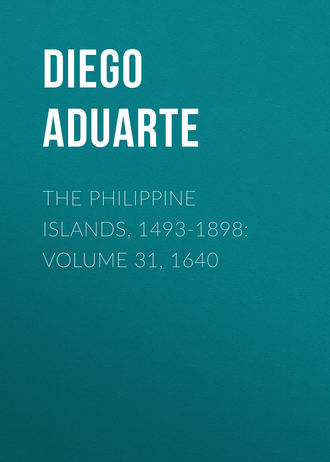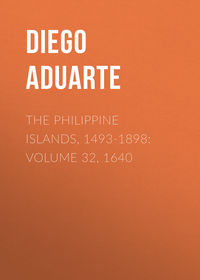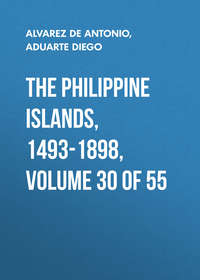 полная версия
полная версияThe Philippine Islands, 1493-1898: Volume 31, 1640
29
i. e., “Christ became, for our sake, obedient even unto death.”
30
Tomás Hernández was sent, soon after his arrival at Manila (1602), to the Japan mission; but at the end of four years he returned with broken health, which compelled him to cease his labors. He lingered, however, until 1642, when he died at Manila.
31
See list of these missionaries in Reseña biográfica, i, pp. 307–319. Thirty-one arrived at Manila, besides the two who died on the way.
32
One of the year-periods used in Japanese chronology (see Vol. VIII, p. 263). The Keicho period is 1596–1615.
33
All these priests became martyrs, except Hernandez; the fate of the lay brother is unknown.
34
One of the Koshiki Islands, lying west of Satsuma, and belonging to that district.
35
Konishi Yukinaga Tsu-no-Kami, a noted general, was converted in 1584, and took the name of Augustin. In 1592 he commanded the main army (composed mainly of Christian Japanese) sent by Taikô-sama for the conquest of Korea. Konishi won renown in that enterprise, in which he was engaged until Taikô-sama’s death (1598) caused the recall of the Japanese troops from Korea. Opposing Iyeyasu, Konishi was among the prisoners taken at the battle of Sekigahara (1600), and was beheaded at Kioto. See Rein’s Japan, pp. 284–288, 290, 299.
36
Owotomo Bungo-no-Kami (called Franciscus by the Jesuits), the most powerful feudal lord in Kiushiu, was one of the first daimiôs in Japan to accept Christianity, and was the main support of the missions in their early years. He died in 1587. The family of this prince were deprived, under Iyeyasu, of their possessions, which were divided among the latter’s adherents. See Rein’s Japan, pp. 273, 519.
37
This was a soldier named Joan Diaz (Vol. XV, pp. 189, 279). Cf. Morga’s account of this Dominican mission (Vol. XV, pp. 279, 280).
38
Jerónimo de Belén, a Portuguese by birth, came in the mission of 1595, from Puebla de los Angeles, Mexico. He ministered at Bataán, Manila, and Cavite respectively; in 1603 went on the Camboja mission, and on its failure returned to Manila. He died in 1642, in Pampanga.
39
Sketches of the lives of all these friars are given in Reseña biográfica, i, pp. 320–327.
40
This friar came in 1604; he died at Nasiping, July 16, 1611.
41
Pedro Muriel came to the islands in 1615, and was sent to the Cagayán missions, where he seems to have spent most of his remaining years. He died at Manila, about 1642.
42
Itaves is a district south of central Cagayán, on the waters of the Rio Chico de Cagayan (or Bangag River). It has over 15,000 inhabitants, contained in more than a hundred villages; these people are mainly Calauas, and are heathen Malays. See U. S. Gazetteer of Philippine Islands, p. 561; also Smithsonian Report, 1899, p. 535.
43
Juan de Naya spent most of his missionary life in Cagayán. Finally being ordered to Mexico, he died on the voyage thither, January 27, 1620.
44
Andres de Haro, a native of Toledo, made his profession at Cuenca in 1613. He came to the Philippines in 1615, and spent more than forty years in the Cagayán missions. At various times he filled important offices in Manila, among them, that of commissary of the Inquisition. He died in that city, September 19, 1670, at the age of seventy-six years.
45
Apparently a reference to the Jesuit Alonso Sanchéz, who had gone in 1586 to Spain (see Vol. VI) as envoy from the various estates of the Philippine colony.
46
i. e., “Farewell in the Lord, beloved of my heart; may you fare well and happily forever.”
47
This was Matsura Shigenobu Hô in, the daimiô of Hirado (Firando) and Iki. He succeeded his father in 1584, and died in 1614, at the age of sixty-five. He was an officer in the Korean campaigns under Konishi, and served during 1592–98. See Satow’s note regarding him, in Voyage of Saris (Hakluyt Society’s publications, London, 1900), p. 79; also his portrait, p. 80.
48
The same as bagacay or bacacae; see Vol. XVI, p. 55.
49
Hizen is one of the most notable provinces of Japan, commercially and historically. Its chief city is Nagasaki, which about 1586 was wrested from the daimiô of Omura by Taikô-sama, and declared the property of the central government. The Dutch maintained a factory there, although under humiliating conditions and restrictions, from 1639 to 1859. Another notable town in Hizen is Arima, where the Christians were so cruelly persecuted in 1637. The daimiô of Hizen, mentioned by Aduarte, was probably Nabeshima, prince of Saga, who was a favorite with Iyeyasu.
See Rein’s Japan, pp. 300, 520–523.
50
Juan de San Jacinto made his profession in the Dominican convent at Salamanca, in 1594. He came to Manila in the mission of 1602, and ministered to the natives in Pangasinan and afterward in Ituy. He was finally compelled by ill-health to retire to Manila, where he died in 1626. See Reseña biográfica, i, p. 316.
51
Pedro de Santo Tomás came to the islands in the mission of 1602, and labored twenty years in the Cagayán missions – especially among the Irrayas, whom he pacified after their revolt against the Spaniards. He died at Lal-ló, June 29, 1622.
52
The Japanese custom of hara-kiri, or seppuku; see description Rein’s Japan, pp. 328, 329; cf. Griffis’s Mikado’s Empire, p. 221.
53
The bonzes are the priests of the Buddhist temples; but they belong to various sects under the general appellation of Buddhism.
54
This daimiô was Shimadzu Yoshihisa; he was commissioned to subjugate the Riu-Kiu Islands, which were then added to the province of Satsuma.
55
i. e., Yamaguchi, in Nagato; the latter is the province at the southwest extremity of Hondo (or Nippon) Island, and lies opposite Kiushiu Island (in which are Satsuma and Hizen).
56
Father Organtinus (Sommervogel can find no distinctive Christian name) was born at Brescia in 1530, and entered the order in 1556. He set out from Lisbon for India in 1567; and soon went to Japan, where he spent the rest of his life, dying at Nagasaki in May, 1609.
Murdoch and Yamagata’s History of Japan, 1542–1651 (Kobe, 1903), gives this Jesuit’s name as Organtino Gnecchi (or Soldi), and the date of his arrival in Japan as 1572; and furnishes considerable information (partly derived from Charlevoix) regarding Gnecchi’s labors in Japan.
57
Takayama (called Justo Ukondono by the Jesuits) the governor of Akashi, in Harima; at Adzuchi-yama, on Lake Birva, he built a house and church for the Jesuits, and otherwise favored them. About 1615, he was, with other Christians, banished to Manila.
Nobunaga became, about the middle of the sixteenth century, the most powerful feudal lord in Japan. He strove to govern the country in the name of the Mikado, but aroused the enmity of the other feudal lords and of the Buddhist priesthood, and was treacherously slain in 1582. See Rein’s Japan, pp. 267–273, 306.
58
Diego Carlos was a native of Guatemala, and made his profession at Puebla de los Angeles in 1592. Six years later, he came to the Philippines, and spent the rest of his life in the Cagayan missions, where he died in 1626.
59
Probably referring to the act of Villamanrique in sending to Spain ignominiously (1588) the Franciscan commissary Alonzo Ponce (Bancroft’s Hist. Mexico, ii, pp. 717, 718).





